Volete installare WordPress sul vostro computer Windows in locale?
Lavorare con WordPress sul computer consente di testare le nuove funzionalità di WordPress, imparare a sviluppare con WordPress e creare siti web prima di migrarli sul server live.
In questo articolo vi mostreremo come installare correttamente WordPress su un computer Windows utilizzando due metodi diversi. Questo metodo funziona su Windows 8, Windows 10 e anche su altre versioni di Windows.
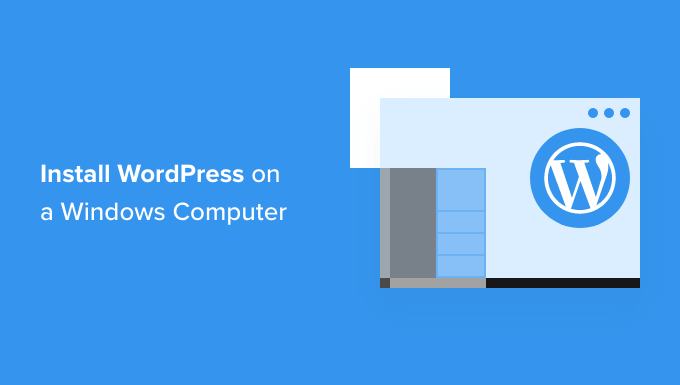
Perché installare WordPress su Windows?
L’installazione di WordPress in locale sul vostro computer vi offre un ambiente di prova che non influisce sul vostro sito web o blog dal vivo. Un’installazione di WordPress sul vostro computer viene anche chiamata server locale o localhost.
Normalmente, gli sviluppatori di WordPress utilizzano un’installazione locale di WordPress per sviluppare i loro plugin e temi WordPress.
Gli utenti principianti possono anche installare WordPress sul proprio computer per imparare WordPress, testare nuovi temi e plugin WordPress e sperimentare senza influire su un sito web attivo.
Nota: se installate WordPress in locale su Windows, l’unica persona che può vedere il sito siete voi.
Se volete creare un sito web disponibile al pubblico, dovete avere un nome di dominio e un hosting web. Vi consigliamo di seguire questa guida su come aprire un blog WordPress.
Detto questo, vediamo come installare correttamente WordPress su un computer Windows. Vi mostreremo due modi semplici, quindi potete fare clic sul link sottostante per passare alla sezione che vi interessa:
- Metodo 1: Installare WordPress su Windows utilizzando WP locale
- Metodo 2: Installare WordPress su Windows utilizzando WampServer
Installare WordPress su Windows utilizzando WP locale
Local WP, precedentemente noto come Local by Flywheel, è un software web locale che consente di ospitare un sito web sul proprio computer anziché su un server di staging o live.
Innanzitutto, è necessario scaricare e installare il software Local WP sul proprio computer Windows. Basta andare sul sito web di Local WP e fare clic sul pulsante “Download for Free”.
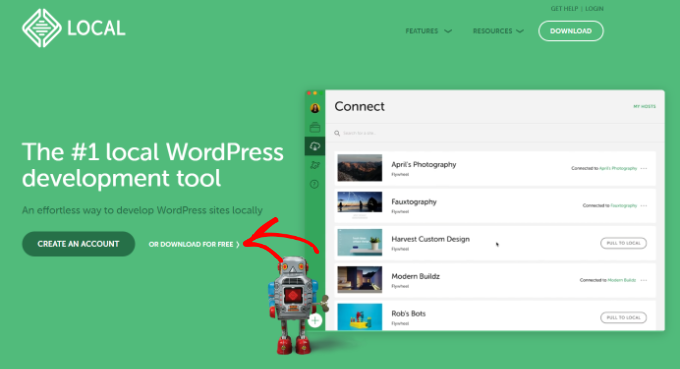
Successivamente, apparirà una finestra popup in cui dovrete selezionare la vostra piattaforma.
Scegliete “Windows” dal menu a discesa.
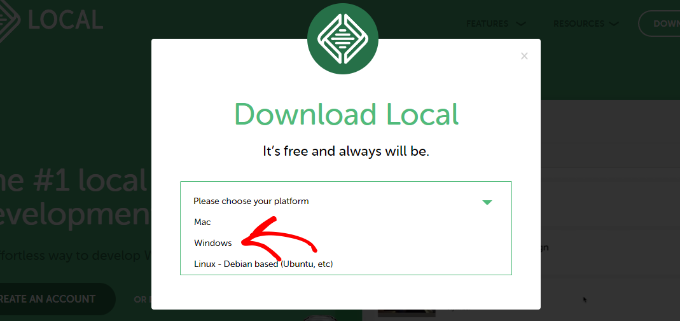
Successivamente, è possibile inserire i propri dati, come nome e cognome, indirizzo e-mail di lavoro e numero di telefono, per scaricare il software.
Dopo aver inserito i dati, è sufficiente fare clic sul pulsante “Ottieni ora”.
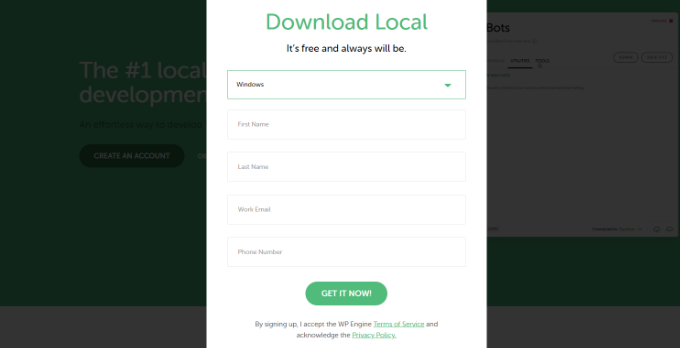
Dopodiché, è possibile scaricare il software sul computer. Una volta scaricato, avviare l’installazione guidata.
Ora dovrete selezionare se volete installare il software per tutti gli utenti o solo per voi. Una volta selezionata l’opzione, fate clic sul pulsante “Avanti”.
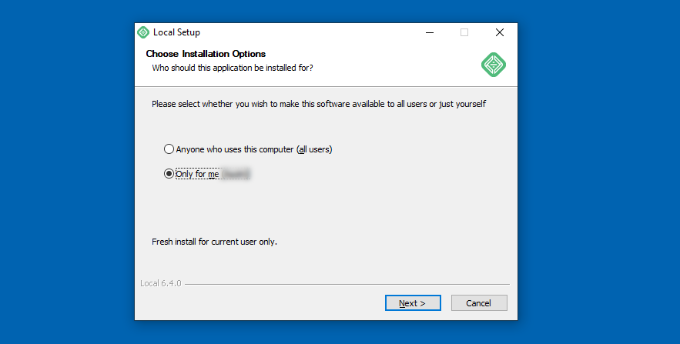
Nel passaggio successivo, è possibile selezionare la “cartella di destinazione” in cui verrà installato il software.
È sufficiente fare clic sul pulsante “Sfoglia” per impostare il percorso e quindi fare clic sul pulsante “Installa”.
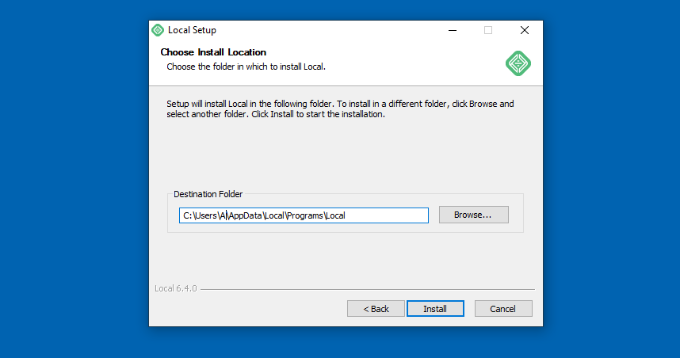
Il software Local WP viene ora installato sul computer Windows.
Una volta terminato, è possibile selezionare la casella di controllo “Esegui in locale” e fare clic sul pulsante “Fine” nella procedura guidata di installazione.
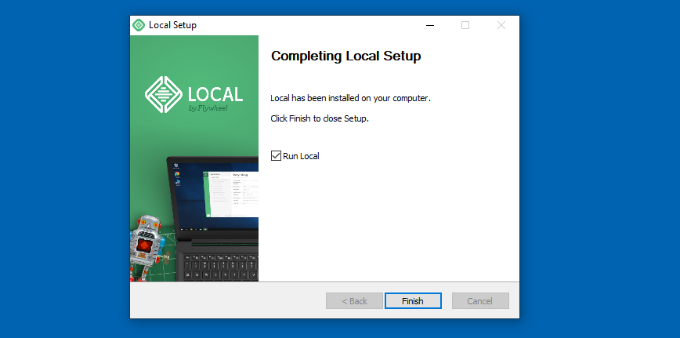
A questo punto il software si avvia sul dispositivo Windows.
Il passo successivo consiste nell’aggiungere un nuovo sito web locale. Per farlo, è sufficiente fare clic sul pulsante più (+) in basso.
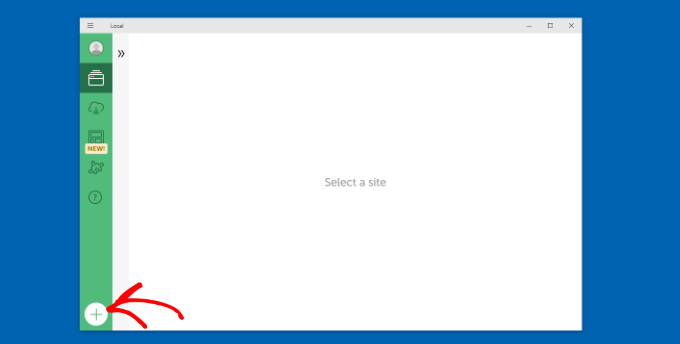
Successivamente, è possibile creare un sito nel software Local.
Selezionate l’opzione “Crea un nuovo sito” e fate clic sul pulsante “Continua”.
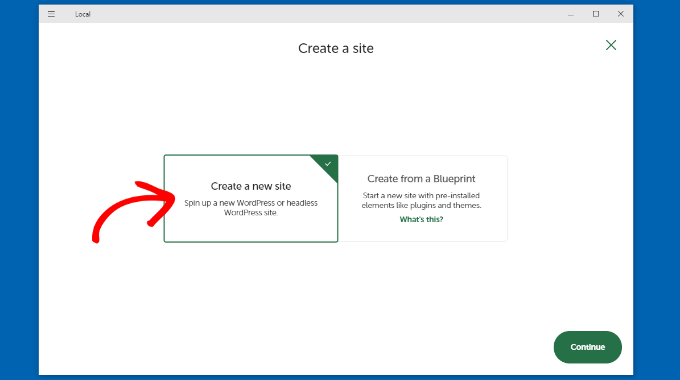
Successivamente, è possibile inserire un nome per il sito web locale, come wordpresslocalsite.
Ci sono anche opzioni avanzate in cui è possibile inserire il dominio del sito locale e il percorso del sito locale. Se si è agli inizi, si consiglia di mantenere le impostazioni predefinite.
Una volta terminato, è sufficiente fare clic sul pulsante “Continua”.
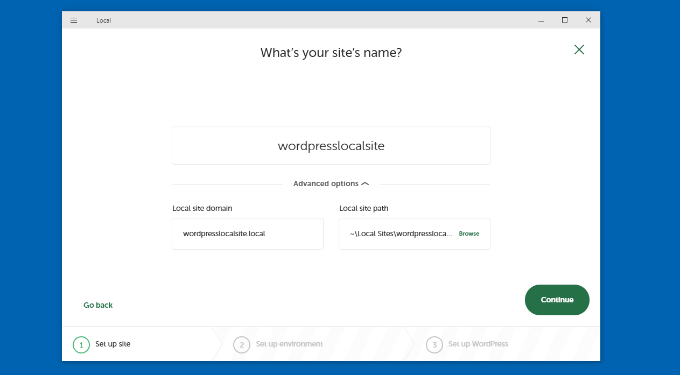
Successivamente, è necessario scegliere un ambiente per il sito web locale.
È possibile utilizzare l’ambiente “Preferito”, in cui il software selezionerà automaticamente la versione di PHP, il server web e la versione di MySQL. D’altra parte, si può anche selezionare “Personalizzato” e inserire i dettagli dell’ambiente.
Per questa esercitazione, utilizzeremo le impostazioni preferite e faremo clic sul pulsante “Continua”.
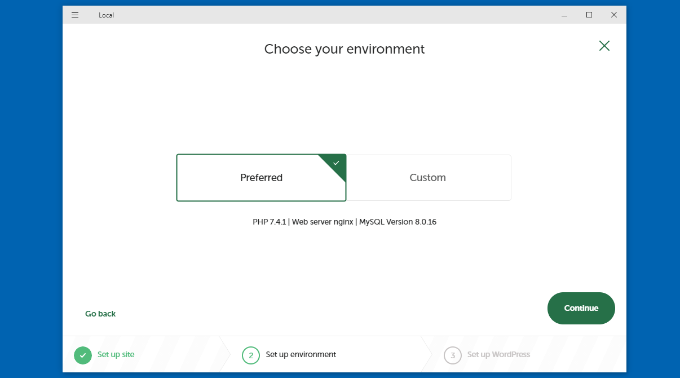
Successivamente, è possibile inserire un nome utente e una password di WordPress per il sito web locale. Inoltre, è possibile scegliere un indirizzo e-mail di WordPress per ricevere tutte le notifiche via e-mail.
C’è anche un’opzione avanzata in cui il software chiede se avete una rete WordPress multisito.
Dopo aver inserito questi dati, è sufficiente fare clic sul pulsante “Aggiungi sito”.
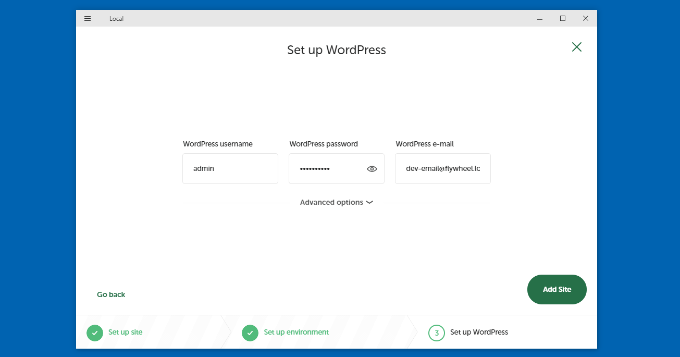
Il software installerà ora WordPress e configurerà il vostro sito web.
Per avviare il sito web locale, fare clic sul pulsante “WP Admin” nel software.
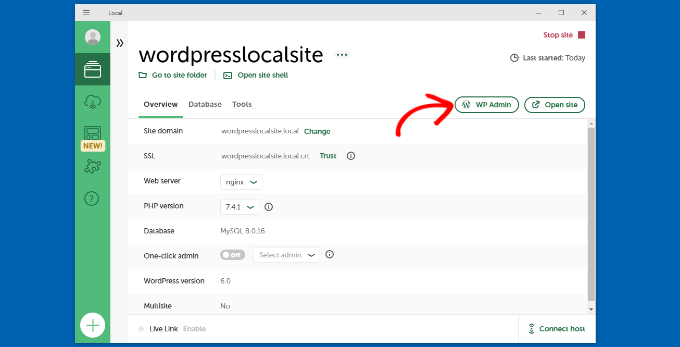
Successivamente, verrà visualizzata la pagina di accesso all’amministrazione di WordPress.
È sufficiente inserire il nome utente e la password immessi in precedenza durante la configurazione del sito web locale e fare clic sul pulsante “Accedi”.
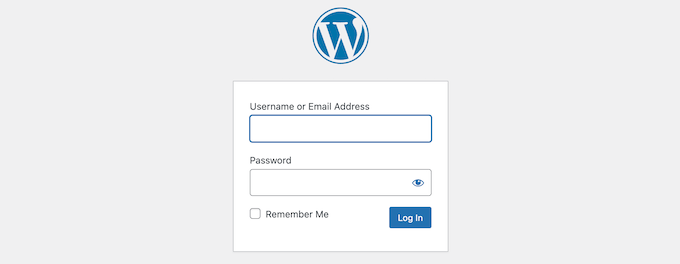
Ora è possibile modificare il sito web locale sul computer Windows.
Una volta terminato, non dimenticate di fermare il sito web dal software Local WP facendo clic sul pulsante “Stop site”.
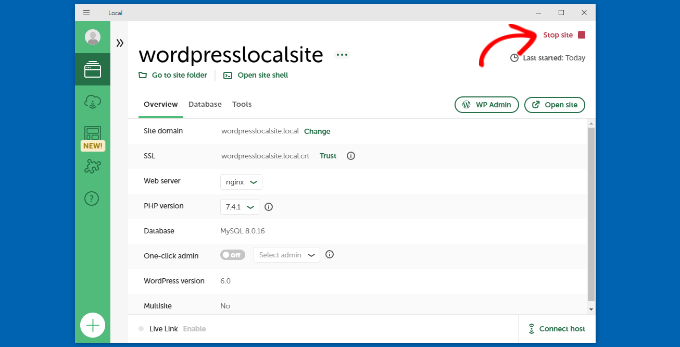
Installare WordPress su Windows utilizzando WampServer
WampServer o WAMP è una compilazione di server web Apache, PHP e MySQL in bundle per computer Windows.
Sono tutti software open-source separati. Tuttavia, installarli separatamente non è facile nemmeno per gli utenti più esperti. Un software come WampServer permette di installarli facilmente e di avere un ambiente locale funzionante in pochi minuti.
Innanzitutto, è necessario scaricare il software WAMP e installarlo sul computer. Basta andare sul sito web di WampServer e cliccare sul pulsante “Start Using WampServer”.
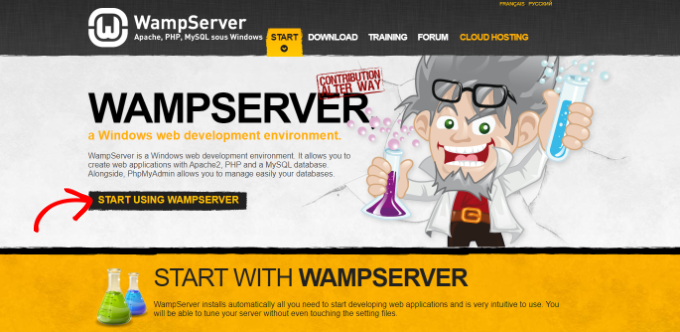
Si accede alla sezione dei download. Qui vedrete due versioni: WampServer 32 bit e WampServer 64 bit.
È necessario selezionare la versione di WampServer che corrisponde al tipo di sistema operativo del computer Windows.
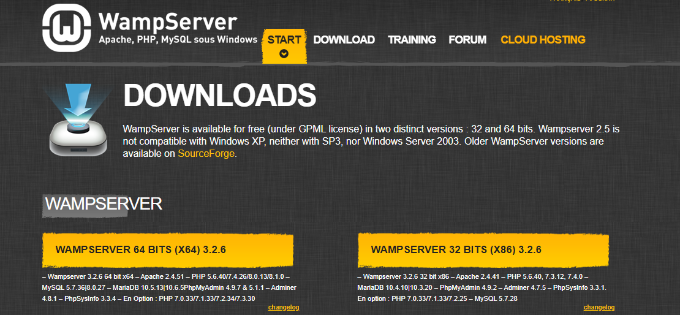
Per sapere se si utilizza un sistema operativo a 32 o 64 bit, è sufficiente cercare “Pannello di controllo” nella barra di ricerca della barra delle applicazioni di Start.
Successivamente, è possibile andare su Sistema e sicurezza ” Sistema del computer. Lì sarà possibile vedere il tipo di sistema.
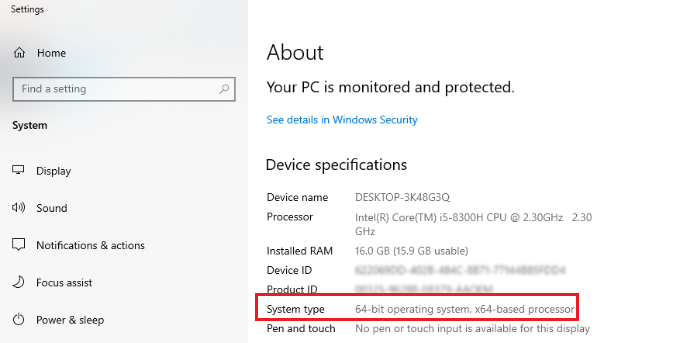
Ora che si conosce il tipo di sistema operativo Windows, è sufficiente selezionare la versione corretta del software WampServer.
Facendo clic sul pulsante di download, si aprirà un modulo che richiede i vostri dati personali. Se non volete fornire queste informazioni, fate pure clic sul link “Puoi scaricarlo direttamente”.
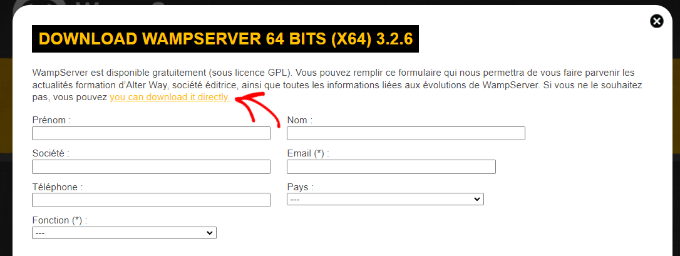
Una volta scaricato, è possibile fare clic sul file di esecuzione di WampServer per eseguire l’installazione.
Ora selezionate una lingua dal menu a discesa e fate clic sul pulsante “OK”.
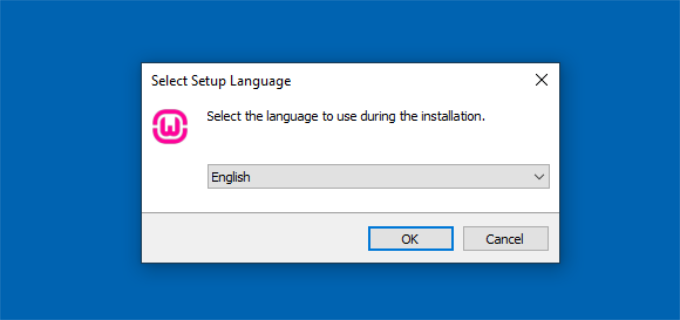
Nel passaggio successivo, verrà visualizzato il Contratto di licenza.
Selezionate l’opzione “Accetto il contratto” e fate clic sul pulsante “Avanti”.
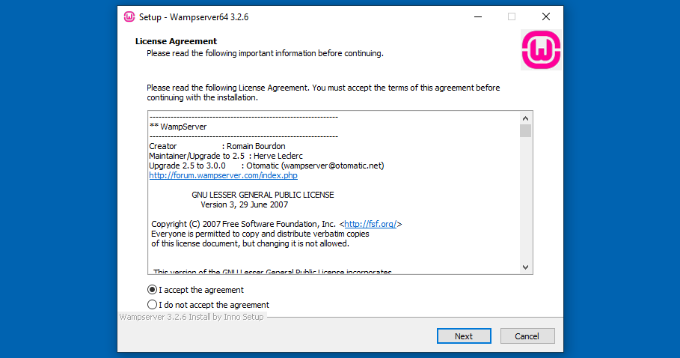
Successivamente, la procedura guidata di installazione mostrerà le informazioni relative all’installazione di WampServer.
È sufficiente fare clic sul pulsante “Avanti” per continuare.
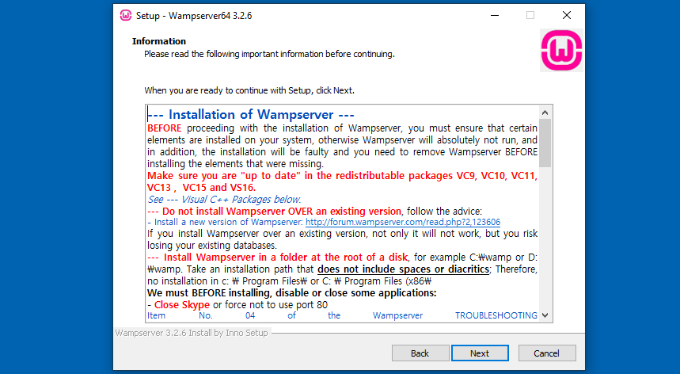
Successivamente, è possibile selezionare il percorso di destinazione in cui verrà installato il software.
Per modificare la posizione predefinita, fare clic sul pulsante “Sfoglia” e scegliere la cartella preferita. Al termine, fare clic sul pulsante “Avanti”.
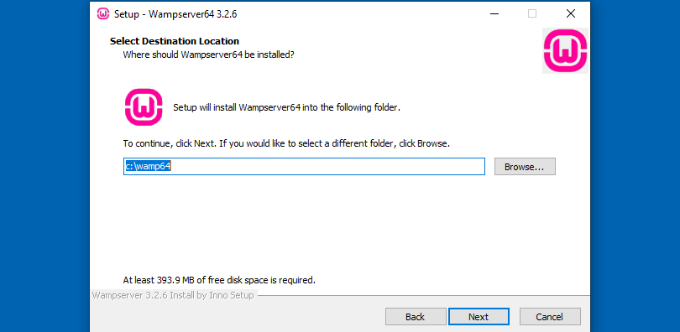
La procedura guidata di installazione chiederà di selezionare i diversi componenti che si desidera installare. Questi includono le versioni di PHP, MySQL e altro ancora.
È anche possibile mantenere le opzioni predefinite e fare clic sul pulsante “Avanti” per andare avanti.
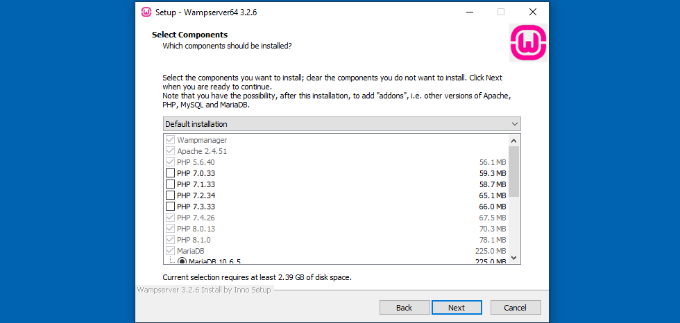
Successivamente, è possibile selezionare una cartella del menu di avvio. Fare clic sul pulsante “Sfoglia” per scegliere una cartella diversa.
Una volta selezionata la cartella, fare clic sul pulsante “Avanti” per continuare.
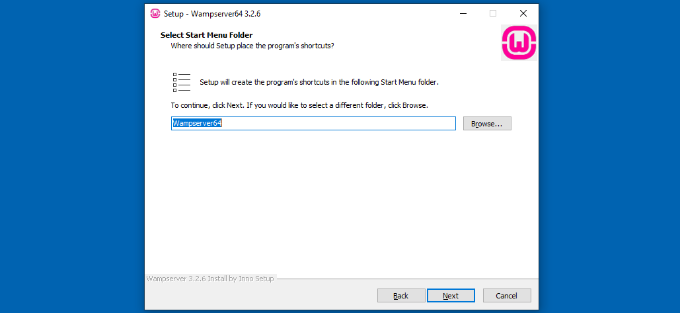
Il software è pronto per essere installato. È possibile visualizzare un riepilogo della posizione di destinazione, del tipo di installazione, dei componenti selezionati e altro ancora.
Fate quindi clic sul pulsante “Installa”.
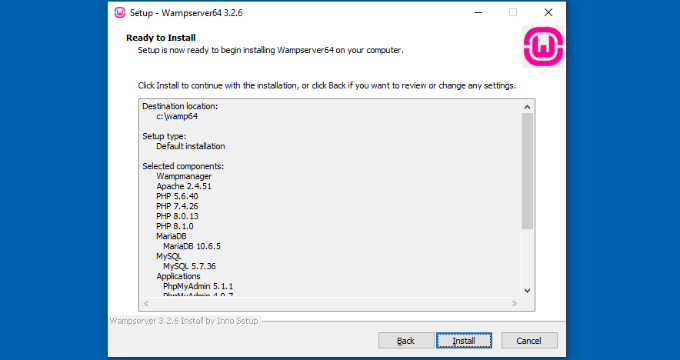
Durante il processo di installazione, è necessario definire la posizione del browser web. Per impostazione predefinita, sarà Internet Explorer.
È possibile passare a Google Chrome o a qualsiasi altro browser web individuandolo nei file di programma del computer.
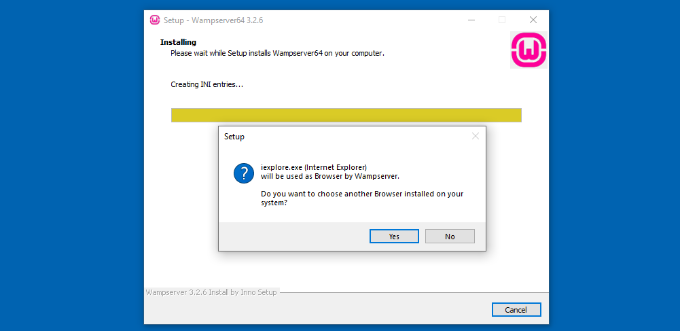
Allo stesso modo, vi chiederà se volete usare Notepad quando usate WampServer.
Dopodiché, la procedura guidata di installazione mostrerà informazioni sul funzionamento di WampServer.
Fare clic sul pulsante “Avanti”.
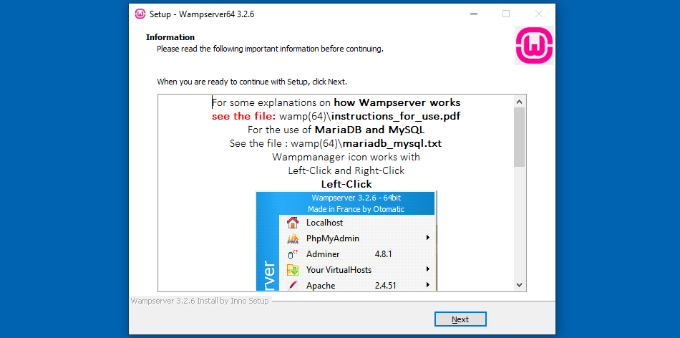
Ora avete installato con successo WampServer sul vostro dispositivo Windows.
È sufficiente fare clic sul pulsante “Fine” per uscire dalla procedura guidata di installazione.
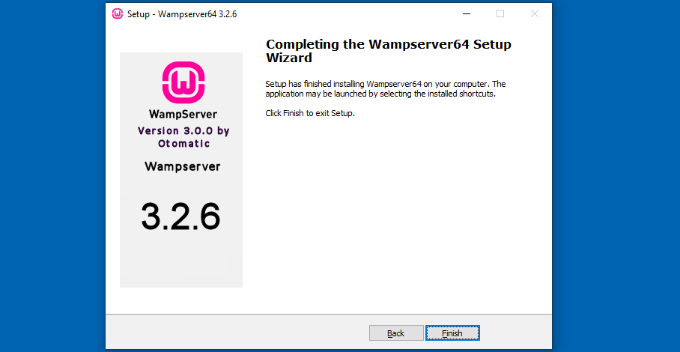
Una volta installato, è possibile lanciare WampServer dal collegamento sul desktop o dalla posizione di destinazione in cui è stato installato il software.
La prossima cosa da fare è creare un database MySQL vuoto.
All’avvio di WampServer, vedrete un’icona verde nell’angolo in basso a destra dello schermo insieme ad altre icone. È sufficiente fare clic con il tasto sinistro del mouse su di essa e poi su phpMyAdmin (un’applicazione basata sul web per gestire i database MySQL).
Nota: Se l’icona di WampServer è rossa o gialla, significa che i servizi (Apache, MySQL, PHP) non sono in esecuzione. È necessario avviare i servizi facendo clic sull’icona prima di configurare il database.
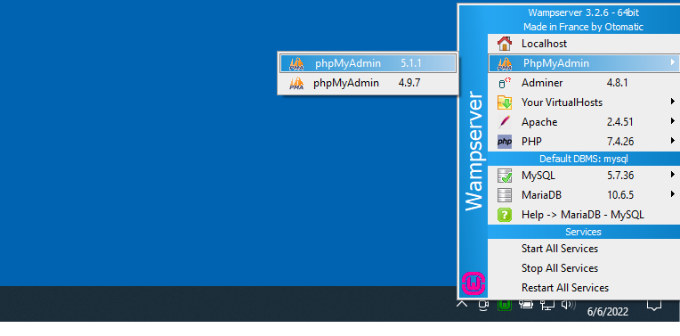
Si aprirà la schermata di accesso a phpMyAdmin sul browser web.
È sufficiente inserire il nome utente: root e lasciare vuoto il campo della password. Queste sono le credenziali predefinite per accedere a phpMyAdmin su localhost.
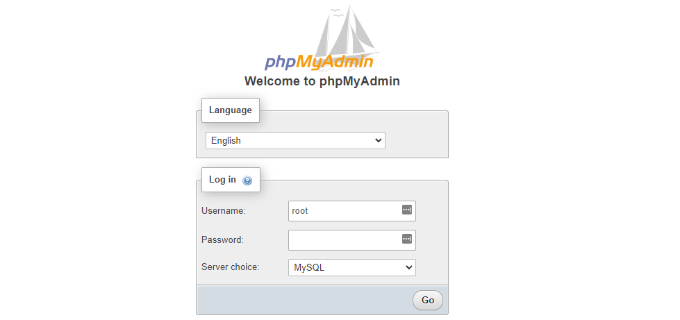
Fare clic sul pulsante “Vai” per continuare.
Una volta effettuato l’accesso, è necessario cliccare su Database in phpmMyAdmin per creare un nuovo database per WordPress.
Verrà chiesto di scegliere un nome per il nuovo database (noi abbiamo chiamato il nostro test_db). Dopodiché, fare clic sul pulsante “Crea”.
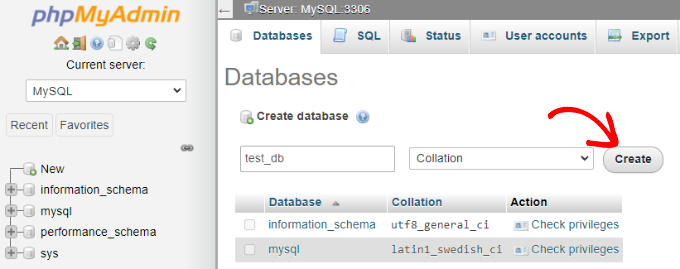
Il vostro database è pronto, il che significa che ora potete installare WordPress su localhost.
La prossima cosa da fare è scaricare l’ultima versione di WordPress dal sito WordPress.org. Verrà scaricato come file zip.
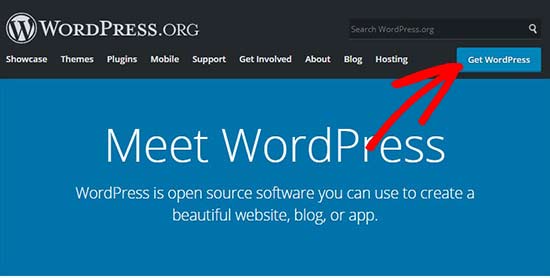
Successivamente, è necessario estrarre il file zip e copiare la cartella ‘wordpress’.
Per questa esercitazione, utilizzeremo WinRAR per decomprimere il file. È sufficiente fare clic sull’opzione “Estrai a” in alto.
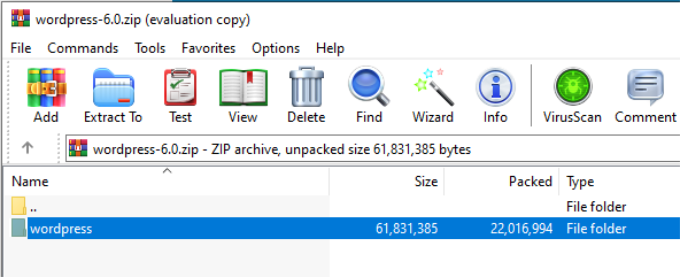
Ora è necessario navigare nella cartella in cui è stato installato WAMP.
In questa guida, abbiamo installato WAMP in C:\wamp64, quindi in futuro faremo riferimento a questa cartella. Tuttavia, tenete presente che potrebbe essere diversa a seconda di dove avete installato il programma.
Incollare la cartella ‘wordpress’ nella cartella C:\wamp64\www.
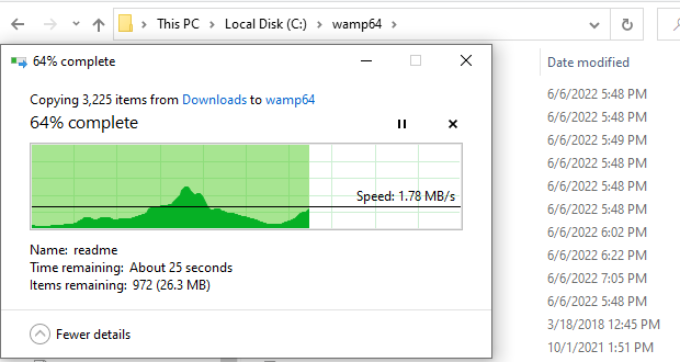
Potete rinominare la cartella “wordpress” con qualsiasi nome, ad esempio mysite, testsite, ecc. Questo sarà l’URL del vostro sito WordPress locale, quindi assicuratevi di scegliere qualcosa che ricorderete facilmente.
Per questo tutorial, abbiamo rinominato la cartella da wordpress a mysite.
Successivamente, è possibile aprire il browser web e andare su http://localhost/mysite/ e fare clic sulla cartella ‘wordpress’.
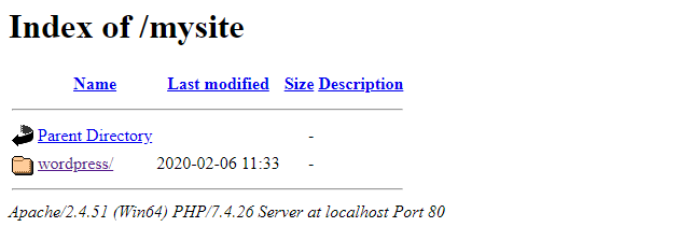
Per prima cosa, vi chiederà di selezionare una lingua e poi vi mostrerà le informazioni di configurazione del database.
Dopo aver selezionato una lingua, fare clic sul pulsante “Continua”.
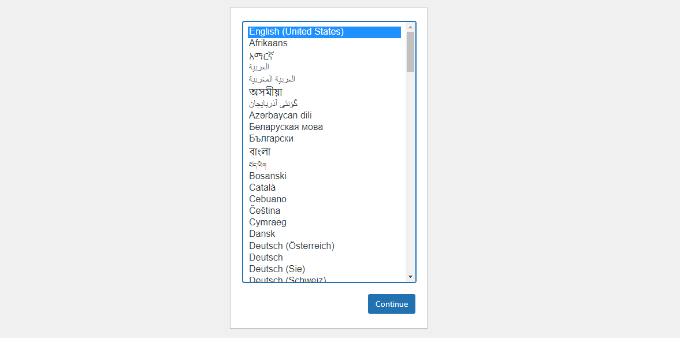
Successivamente, verrà visualizzato un avviso di benvenuto a WordPress.
Una volta letto con attenzione, fare clic sul pulsante “Let’s go” per continuare.
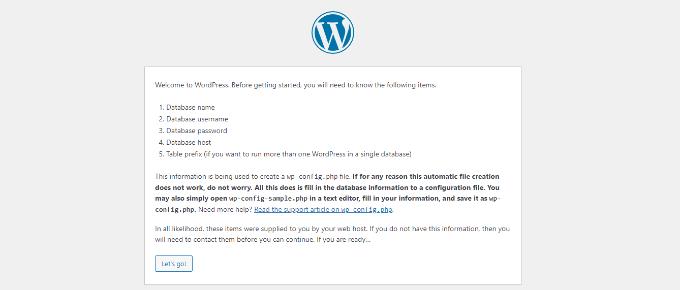
Successivamente, è necessario inserire i dettagli del database, come il nome del database, il nome utente, la password, l’host e il prefisso della tabella.
Il nome del database sarà quello inserito nel passaggio precedente. Nel nostro caso, lo abbiamo chiamato “test_db”. Il nome utente sarà ‘root’ e si può lasciare vuoto il campo della password. Si possono anche lasciare invariati l’host del database e il prefisso della tabella.
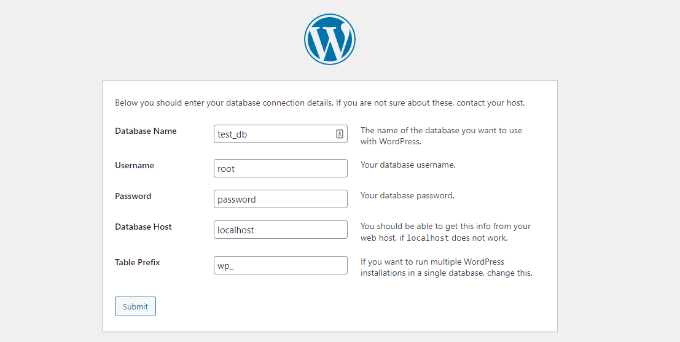
Quindi, fare clic sul pulsante “Invia” e WordPress creerà un file di configurazione per voi nel backend.
Nella schermata successiva, verrà visualizzato un messaggio di successo che indica che WordPress è connesso al database e che è possibile procedere con l’installazione.
Fare clic sul pulsante “Esegui l’installazione” per continuare.
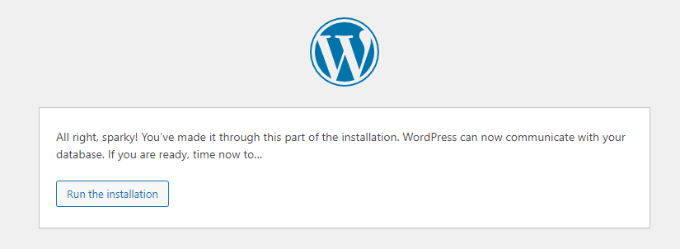
Si aprirà la schermata di benvenuto di WordPress. È necessario aggiungere un titolo per il nuovo sito web WordPress, scegliere un nome utente amministratore, inserire una password forte e fornire un indirizzo e-mail amministratore.
Una volta pronti, fate clic sul pulsante “Installa WordPress”.
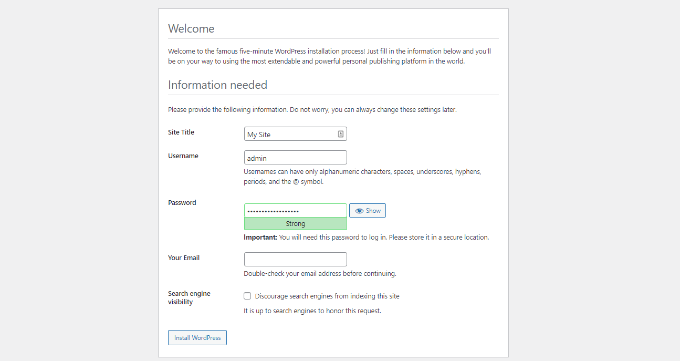
Al termine del processo di installazione, verrà visualizzato un messaggio di successo. In background, WordPress ha creato nuove tabelle nel database ed è pronto all’uso.
Potete quindi accedere alla vostra dashboard di WordPress facendo clic sul pulsante “Accedi”.
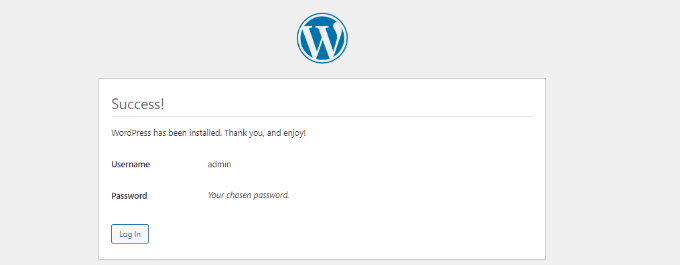
Congratulazioni, avete installato con successo WordPress su un computer Windows utilizzando WampServer.
È sufficiente accedere al pannello di amministrazione di WordPress e iniziare a modificare il sito in un ambiente locale.
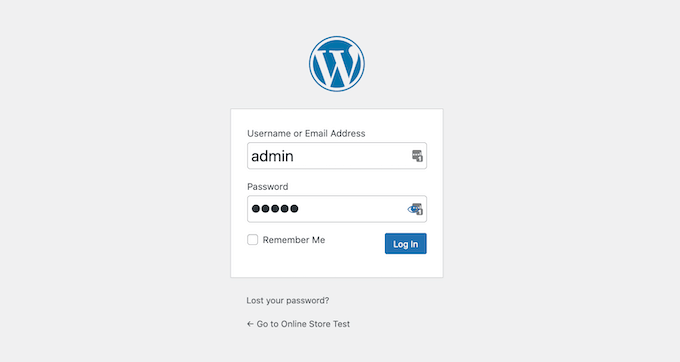
Abilitazione dei permalink graziosi in WAMP
La nuova versione di WordPress non rompe il vostro sito locale modificando l’impostazione dei permalink.
Tuttavia, se dopo aver modificato i permalink da Impostazioni ” Permalinks in WordPress, le pagine continuano a presentare l’errore “pagina non trovata”, seguite la nostra guida su come abilitare i permalink personalizzati in WAMP.
Bonus: Migrazione di WordPress da Local a Live
Abbiamo anche scritto una guida separata su come spostare WordPress dal server locale a un sito live. Speriamo che vi sia utile quando sarete pronti a distribuire il vostro sito locale in produzione.
Avere un ambiente server locale è ottimo per scopi di apprendimento e di test. Tuttavia, se volete aprire un blog WordPress che sia visibile ad altre persone, non avete bisogno di installare WordPress sul vostro computer. È necessario installare WordPress su un provider di hosting WordPress.
Speriamo che questo articolo vi abbia aiutato a capire come installare WordPress su un computer Windows. Potreste anche voler consultare le nostre guide su WordPress SEO e su come avviare un negozio online.
Se questo articolo vi è piaciuto, iscrivetevi al nostro canale YouTube per le esercitazioni video su WordPress. Potete trovarci anche su Twitter e Facebook.





Syed Balkhi says
Hey WPBeginner readers,
Did you know you can win exciting prizes by commenting on WPBeginner?
Every month, our top blog commenters will win HUGE rewards, including premium WordPress plugin licenses and cash prizes.
You can get more details about the contest from here.
Start sharing your thoughts below to stand a chance to win!
Moinuddin Waheed says
This is the best method for anyone who just want to learn and gets hands dirty before actually making a big debut in the WordPress industry.
I have used both the methods local by flywheel and wampserver for local installation of WordPress.
I have also used xampp server for wordpress installation and have experimented with many themes and plugins.
Konrad says
Everything went smoothly, no issues with installation, thanks to the simple yet effective guide. Much appreciated!
WPBeginner Support says
Glad to hear it worked for you
Admin
saajina says
Hi. i am new to WordPress and i am trying to install WampServer. i downloaded WampServer from the link you mentioned above. and i tried to install after download , i choose english language after that i accepted the agreement. after that when i click on the next button to install a pop come by saying this installation can only work if the above vc++ package is installed ……. and please cancel the installation . i don’t know what to do next. please help me
WPBeginner Support says
It would depend on which VC++ package is missing but you should be able to go to the Microsoft website and search for the Visual C++ library that WAMP needs to download and install it.
Admin
Jiří Vaněk says
Thank you for the guide. Usually, I’ve always tested WordPress, for instance, on services like instawp.com, or I’ve set up everything myself in some virtualization tool on a Linux distribution. This looks quite simple.
WPBeginner Support says
Glad you found this a helpful option
Admin
sieutonghop says
Is Local WP website data guaranteed?
WPBeginner Support says
I don’t think I understand what you’re asking, the files and your content are stored on your computer.
Admin
kiemtienspeed says
If using Local WP, where will the website data be saved? Can you explain more clearly?
WPBeginner Support says
The data would be stored in the database and the files would be saved in the site’s folder.
Admin
Jiří Vaněk says
It’s practically the same as with WordPress on shared hosting. The database can then be exported via PHPMyAdmin, and data via an FTP client (FTP data is stored in a folder locally on the computer). Alternatively, a migration plugin can be used, just like on the server.
Koweh says
Hi, please is the a video explainable for the above steps to install Install WordPress on Windows Using WampServer?
WPBeginner Support says
Not at the moment but we will consider that for future videos!
Admin
M Sohail says
this article is very helpful to me.
Thanks to all Team
WPBeginner Support says
Glad to hear our post was helpful!
Admin
Danielle says
Hi, very helpful article. How would you do this for an existing WordPress site? (I’m hosting on Hostinger and selected WordPress to construct my site). I already have a domain name and login for WordPress as well.
WPBeginner Support says
To move a currently active site to a locally installed WordPress site, you would want to take a look at our guide below!
https://www.wpbeginner.com/wp-tutorials/how-to-move-live-wordpress-site-to-local-server/
Admin
Joseph Lewinski says
Fabulous instruction set. I installed WAMP Server simply and without a hitch. There was only one very minor “glitch” in your instructions, which were easy enough to figure out. When the instructions explain the installation of WordPress proper, it says, “Paste the ‘wordpress’ folder into the C:\wamp64\www folder.”, but the IMAGE shows you installing it into the C:\wamp64 folder. Like I said, easy enough to figure out (I used your WORDS, NOT the IMAGE).
THANK YOU for this! I’m subscribing NOW!
WPBeginner Support says
Glad our guide was helpful and thank you for pointing that out!
Admin
Duncan Philps-Tate says
Hi useful article. The only thing I’m aware of not seeing is anything about when to use Local WP and when to use WAMP. Now I’ve got a choice and I don’t know which is better for me.
Local WP sounds more straightforward and with less to do – but the test doesn’t say whether it also installs Apache, PHP, MySQL (which the WAMP text does say).
On the other hand, WAMP sounds like you have to do more getting it going (just compare the number of paragraphs it needs) but apart from (possibly) adding choice over Apache, PHP, MySQL, what does it give you that Local WP doesn’t?
Hope you can answer this easily.
WPBeginner Support says
WAMP has been around longer and was our original recommendation, Local WP was created to make it easier for those just starting out and both will install what is needed to run a WordPress site on your computer.
Admin
Duncan Philps-Tate says
Thanks – useful
Seyi says
Thanks for this… really helpful
WPBeginner Support says
Glad our article was helpful!
Admin
Kylie says
I have installed wampserver and have a green light. When I right click I can not find any button called phpadmin. And when I type localhost/phpadmin in my browser I am getting this message.
The requested URL was not found on this server.
Apache/2.4.51 (Win64) PHP/7.4.26 Server at localhost Port 80
WPBeginner Support says
You would want to left-click on WAMP’s icon for phpmyadmin, when you go through that route it should show what your URL is set to if it is not properly set under localhost.
Admin
Layla says
I’ve done this and started work on one pc but this now needs to go for repair and will be away a while. If I am to install this on a second pc, what files do I need to transfer over so I can continue working on the same website on the other pc? Feeling a bit dumb here that I can’t figure it out myself.
WPBeginner Support says
We would recommend following our guide below for transferring your site to a different computer to continue working on it. While the article is for live sites, the method should still work for your local installation.
https://www.wpbeginner.com/wp-tutorials/how-to-move-live-wordpress-site-to-local-server/
Admin
Layla says
Thank you so much! That worked perfectly and was so simple!
WPBeginner Support says
Glad we could help!
Renata says
I installed Wamp Server and C++ Redistributable 2012, 2013 and 2015 but when I try to open it it opens 4 black windows and then it shuts down. What should I do
WPBeginner Support says
You would want to check in the bottom right with your hidden icons, WAMP does not have a window pop up by default but would add an icon there for your options with WAMP
Admin
Hosea says
Straightforward and to the point guide. Followed it and achieved exactly what I wanted. Great and helpful write-up.
WPBeginner Support says
Glad you found our guide helpful
Admin
Ibrahim Yusuff says
Thanks for this invaluable guide. The issue of having is with the wamp download. The language is in French and each time i try to change it it goes back to french which i do not understand. i filled all the necessary information but to click on download it changes back to french. pls help me out on this
WPBeginner Support says
They currently have a popup that is French when selecting the file to download but at the end of the first paragraph you should see a link to download directly without having to deal with the popup
Admin
prilla kobugabe says
hello, i need some help. when i put this localhost/mysite/ in my web browser it responds negatively saying
“The requested URL was not found on this server.
Apache/2.4.41 (Win64) PHP/7.3.12 Server at localhost Port 80”
WPBeginner Support says
If you have restarted your computer since installing WAMP you would want to ensure that WAMP is running as that is the most common cause of that specific error.
Admin
Ronnie Ferrer says
You are legend guys! Thanks.
Francis Guchie says
Thank you so much for this very nice article for beginners
prakoo says
api-ms-win-crt-string-l1-1-0.dll is missing from your computer it shows error?
WPBeginner Support says
You would want to ensure you install Visual C++ Pro for the most common solution to that error.
Admin
Melissa says
Hi – I have WAMP installed locally on my Windows 10 machine running PHP version: 7.3.12. I want to upgrade to PHP 7.4 – do I need to reinstall WAMP or can I update PHP separately?
WPBeginner Support says
You would want to click on the WAMP icon, and check under PHP, Version and depending on when you installed WAMP there should be the option to change versions by clicking on the version you want to use.
Admin
melissa says
thanks – this was perfect advice!
Holly says
Thanks for this article! It is the best and most straight-forward one I’ve come across, it’s very helpful and detailed. Keep up the great work! As a beginner, I really appreciate it.
WPBeginner Support says
Glad you found our guide helpful
Admin
Jules Ivan says
This is awesome! Thank you for making this article!
WPBeginner Support says
Glad you found our guide helpful
Admin
Ben says
While installing, I got a System error that says ”The code execution cannot proceed because MSVCR120.dll was not found. Reinstalling the program may fix this problem'”
How can I get this done please
WPBeginner Support says
You need to install Visual C++ Redistributable that we link to in the article
Admin
Diya says
I have installed wordpress in wamp and completed my first website. I have got another project now. So for the second website how should I start?Should I install wordpress again in a second “mysite2” folder?
WPBeginner Support says
You can certainly do that for the most common method for creating a new site.
Admin
saheed says
im receiving myssqld.exe- system error. how do i fix it
WPBeginner Support says
You would want to ensure you installed Visual C++ Redistributable
Admin
Tom Bauer says
WAMP64 will not install on a win7 64 machine.
WPBeginner Support says
Unless we hear otherwise, you can install it on Windows 7 still, depending on the error you are running into, you may need to reach out to WAMP’s support.
Admin
Paul says
Great instructions, thanks.
Everything installed fine, just have a problem this morning in trying to log into the browser. Every setting I have tried hasn’t worked.
I know I am being thick but could you confirm what I should be typing in the browser to access the program.
Thanks
WPBeginner Support says
As we state in the article, it should be something similar to localhost/mysite. You would also want to ensure WAMP is running for the most common reason for that issue.
Admin
Peter says
I was having similar issue as others. All went well until I got to the point with Apache not running. The issue was with Port 80 it was used by something else (not skype) so I went to Tools > Use other port than 80 I added the port 8080. Then it all worked however then when you want to access your website you can’t use localhost/mysite/ but localhost:8080/mysite/ since you changed the default port.
I didn’t find this in the comments. Maybe it will help someone.
WPBeginner Support says
Thanks for sharing what helped you with this issue
Admin
Bas says
Hi, thanks for the tutorial. I completed it, and it works like a charm. But now my question is: how do I get my “real” live website data in the local test environment? Is there some way to export that and import it into the local test environment?
WPBeginner Support says
For that, you would want to take a look at our article below:
https://www.wpbeginner.com/wp-tutorials/how-to-move-live-wordpress-site-to-local-server/
Admin
Mahima Pandey says
here i have downloaded the wordpress file and done everything according to the given instruction . but lastly stuck in the localhost address bar
localhost/servername in the internet explore has to be typed to get to wordpress. but what to be type for google ,firefox. pls lhelp me with this its really urgent.
WPBeginner Support says
You should be able to type that same address on any internet browser to see the site on your local computer. If you wanted to have your site found online, you would want to look into a domain and hosting provider.
Admin
Konstantinos Paturas says
Thank you so much.
WPBeginner Support says
You’re welcome
Admin
Armel says
Thanks for this useful article. I successfully installed WordPress using Wamp. But, I get this message. “Installation failed: there has been a critical error on your website. Please check your site admin email inbox for instructions. Learn more about debugging in WordPress.”
Please, how can i fix it ?
WPBeginner Support says
For that error, you would want to take a look at our article below:
https://www.wpbeginner.com/wp-tutorials/how-to-fix-the-wordpress-white-screen-of-death/
Admin
Hoat Le says
Dear WPBeginner Support;
I read your tut very carefully, and didn’t see you mention about VirtualHost in WampServer, so I don’t know if I have to create a Virtual Host for my test site.
WPBeginner Support says
It can make URLs closer to what you would expect from a site but it is not a requirement and can be difficult for beginners to set up.
Admin
Shani says
Hello,
Thank you so much for this article!
You’ve really helped me!
I’m interested to know now how to login to my site when I go on wordpress.
WPBeginner Support says
If you can navigate to your WordPress site then you would add /wp-admin to the end, we cover a few more options in our article below that you can also try:
https://www.wpbeginner.com/beginners-guide/how-to-find-your-wordpress-login-url/
Admin
mimi says
I followed the process accordingly but when i click on the green WAMP icon in order to create a blank MySQL database nothing pops up
WPBeginner Support says
The most common reason for that would be if you didn’t install the C++ redistributable if you have not done that.
Admin
Aminat says
Thanks a lot, really helpful
WPBeginner Support says
You’re welcome
Admin
Dav says
Hi,
I have installed as per instructions but I am getting an error trying to log into
ERROR: Failed to set session cookie. Maybe you are using HTTP instead of HTTPS to access phpMyAdmin.
What am I doing wrong?
WPBeginner Support says
That is likely a hiccup with either your browser cache or a browser addon, we would recommend clearing your cache or trying to use an incognito browser to see if that helps resolve the issue.
Admin
Dav says
Thanks, that works
Nathan Zindikilani says
Hi, thank you for the article. when i try to open my local host site i get the following error; There has been a critical error on your website.this is after pasting ‘wordpress’ to www folder. how may i solve this
WPBeginner Support says
You would want to ensure the file is unzipped, if it is you may want to try reading a fresh WordPress download to the folder to see if there was a hiccup with your download.
Admin
Spyros says
Hi, i need your help please, i follow all the steps in your detailed article but i saw a message “can’t select database We were able to connect to the database server (which means your username and password is okay) but not able to select the test_db database and some other that i believe you know”.
Thanks in advance!
WPBeginner Support says
You may want to ensure there are no typos in the database name you set, it looks like it is not able to find a database with the name given.
Admin
Raheel says
I am getting “Error establishing a database connection”
Any help here please
WPBeginner Support says
For common solutions to that error, you would want to take a look at our article below:
https://www.wpbeginner.com/wp-tutorials/how-to-fix-the-error-establishing-a-database-connection-in-wordpress/
Admin
Steve says
Hi,
I have installed WAMP and created a WordPress site on my computer – thanks for your excellent guide. I used “mysite” as in your example to stay consistent with you as I built my software kingdom. Now that things are looking good, is it possible to simply rename the “mysite” folder (which is inside “www” to my preferred name, or is it more complicated than that? I’m trying to avoid starting over. Thanks
WPBeginner Support says
We would recommend staying with the format you’ve set up already if possible and once you have hosting ready we would recommend taking a look at our guide below:
https://www.wpbeginner.com/wp-tutorials/how-to-move-wordpress-from-local-server-to-live-site/
Admin
Francesco says
Hi,
Can I use this system to test a previous back up I did via the server control panel?
I have a zip file which is a mirror of my directory on the server, including database and WP-admin file.
I would line to test if the backup I have works fine and possible run it on a precioys version of the WP
WPBeginner Support says
You would want to check with the tool you are using for the specifics but it should allow you to do what you’re wanting.
Admin
Melissa T says
Installed WAMP and WordPress – thanks for the wonderfully detailed instructions! So now it’s time to create the web site — is there a guide on wpbeginner for that?
thank you!
WPBeginner Support says
There are many different types of sites so there is no complete guide but for a starting point you may want to take a look at our article below. Step 3 and beyond in the guide should help.
https://www.wpbeginner.com/guides/
Admin
kwestyon says
First, thank you so much for the guide! It’s working. Second, is there a way wherein after you create the website, would there a way to view the site after you clicked the published button. Sorry for the dumb question.
WPBeginner Support says
If you are logged in, in the top right you should be able to open the dropdown that has your site title, and there you should find a link to view your site.
Admin
Yomi says
Hello,
If I install WordPress on a localhost based on the content of this blog, will I be able to use plugins like woocommerce, elementor, astra & kadence?
Thank you.
WPBeginner Support says
Yes, installing locally you would be able to use plugins and page builders like those on your site
Admin
Lisa says
Hi,
I am at the point where I would put localhost/mysite/ in the browser. I am getting the “404 not found error”.
I named the copy of wordpress to wamp the same and have double checked the address to see if it’s typed in correctly. This still happens, what am I doing wrong?
Thanks!
WPBeginner Support says
You would want to ensure you’re not running into the Skype error where it is trying to use port 80 while WAMP is.
Admin
WPBeginner Support says
Currently, the WAMP website is down which is why we’ve added a different link and included a note above and are working on updating this article as quickly as we are able
Admin
mark says
WAMP link redirects to a different site.